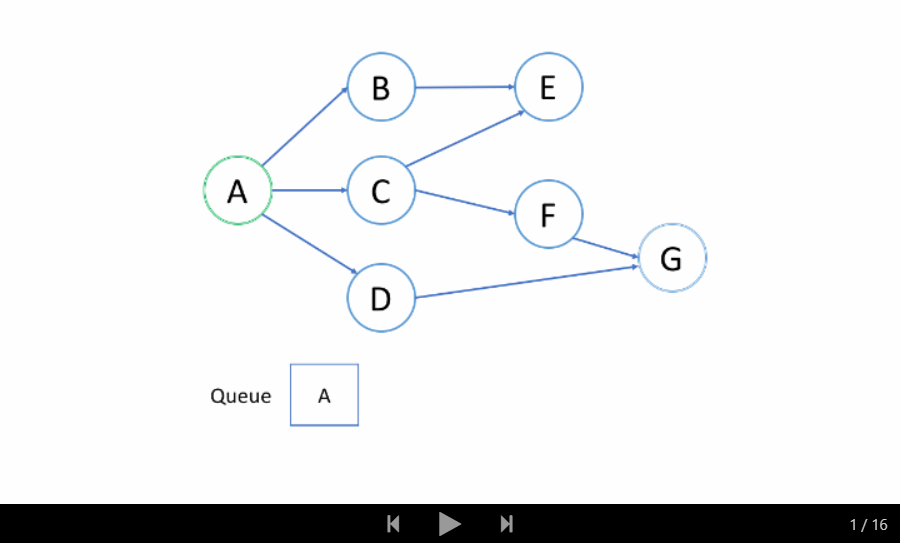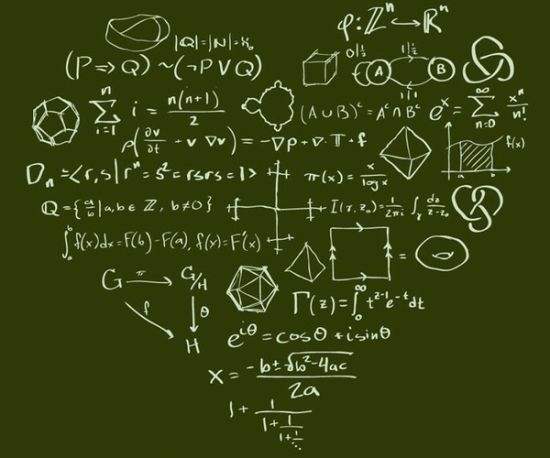leetcode探索之队列 & 栈学习 队列和广度优先搜索
作者:whisper
链接:http://proprogrammar.com:443/article/593
声明:请尊重原作者的劳动,如需转载请注明出处
先决条件:树的层序遍历
广度优先搜索(BFS)是一种遍历或搜索数据结构(如树或图)的算法。
如前所述,我们可以使用 BFS 在树中执行层序遍历。
我们也可以使用 BFS 遍历图。例如,我们可以使用 BFS 找到从起始结点到目标结点的路径,特别是最短路径。
我们可以在更抽象的情景中使用 BFS 遍历所有可能的状态。在这种情况下,我们可以把状态看作是图中的结点,而以合法的过渡路径作为图中的边。
本章节中,我们将简要介绍 BFS 是如何工作的,并着重关注队列如何帮助我们实现 BFS 算法。我们还将提供一些练习,供你自行设计和实现 BFS 算法。
队列和 BFS
广度优先搜索(BFS)的一个常见应用是找出从根结点到目标结点的最短路径。在本文中,我们提供了一个示例来解释在 BFS 算法中是如何逐步应用队列的。
示例
这里我们提供一个示例来说明如何使用 BFS 来找出根结点 A 和目标结点 G 之间的最短路径。

洞悉
观看上面的动画后,让我们回答以下问题:
1. 结点的处理顺序是什么?
在第一轮中,我们处理根结点。在第二轮中,我们处理根结点旁边的结点;在第三轮中,我们处理距根结点两步的结点;等等等等。
与树的层序遍历类似,越是接近根结点的结点将越早地遍历。
如果在第 k 轮中将结点 X 添加到队列中,则根结点与 X 之间的最短路径的长度恰好是 k。也就是说,第一次找到目标结点时,你已经处于最短路径中。
2. 队列的入队和出队顺序是什么?
如上面的动画所示,我们首先将根结点排入队列。然后在每一轮中,我们逐个处理已经在队列中的结点,并将所有邻居添加到队列中。值得注意的是,新添加的节点不会立即遍历,而是在下一轮中处理。
结点的处理顺序与它们添加到队列的顺序是完全相同的顺序,即先进先出(FIFO)。这就是我们在 BFS 中使用队列的原因。
广度优先搜索 - 模板
之前,我们已经介绍了使用 BFS 的两个主要方案:遍历或找出最短路径。通常,这发生在树或图中。正如我们在章节描述中提到的,BFS 也可以用于更抽象的场景中。
在本文中,我们将为你提供一个模板。然后,我们在本文后提供一些习题供你练习。
在特定问题中执行 BFS 之前确定结点和边缘非常重要。通常,结点将是实际结点或是状态,而边缘将是实际边缘或可能的转换。
模板 I
在这里,我们为你提供伪代码作为模板:
/**
* Return the length of the shortest path between root and target node.
*/
int BFS(Node root, Node target) {
Queue<Node> queue; // store all nodes which are waiting to be processed
int step = 0; // number of steps neeeded from root to current node
// initialize
add root to queue;
// BFS
while (queue is not empty) {
step = step + 1;
// iterate the nodes which are already in the queue
int size = queue.size();
for (int i = 0; i < size; ++i) {
Node cur = the first node in queue;
return step if cur is target;
for (Node next : the neighbors of cur) {
add next to queue;
}
remove the first node from queue;
}
}
return -1; // there is no path from root to target
}- 如代码所示,在每一轮中,队列中的结点是等待处理的结点。
- 在每个更外一层的 while 循环之后,我们距离根结点更远一步。变量 step 指示从根结点到我们正在访问的当前结点的距离。
模板 II
有时,确保我们永远不会访问一个结点两次很重要。否则,我们可能陷入无限循环。如果是这样,我们可以在上面的代码中添加一个哈希集来解决这个问题。这是修改后的伪代码:
/**
* Return the length of the shortest path between root and target node.
*/
int BFS(Node root, Node target) {
Queue<Node> queue; // store all nodes which are waiting to be processed
Set<Node> used; // store all the used nodes
int step = 0; // number of steps neeeded from root to current node
// initialize
add root to queue;
add root to used;
// BFS
while (queue is not empty) {
step = step + 1;
// iterate the nodes which are already in the queue
int size = queue.size();
for (int i = 0; i < size; ++i) {
Node cur = the first node in queue;
return step if cur is target;
for (Node next : the neighbors of cur) {
if (next is not in used) {
add next to queue;
add next to used;
}
}
remove the first node from queue;
}
}
return -1; // there is no path from root to target
}有两种情况你不需要使用哈希集:
- 你完全确定没有循环,例如,在树遍历中;
- 你确实希望多次将结点添加到队列中。
算法-墙与门
你被给定一个 m × n 的二维网格,网格中有以下三种可能的初始化值:
- -1 表示墙或是障碍物
- 0 表示一扇门
- INF 无限表示一个空的房间。然后,我们用 231 - 1 = 2147483647 代表 INF。你可以认为通往门的距离总是小于 2147483647 的。
你要给每个空房间位上填上该房间到 最近 门的距离,如果无法到达门,则填 INF 即可。
示例:
给定二维网格:
INF -1 0 INF INF INF INF -1 INF -1 INF -1 0 -1 INF INF运行完你的函数后,该网格应该变成:
3 -1 0 1 2 2 1 -1 1 -1 2 -1 0 -1 3 4
class Solution {
// 找门,从门bfs,如果到房间距离比原来的值小,则更新并处理下一层
public void wallsAndGates(int[][] rooms) {
Queue<int[]> queue = new LinkedList<>();
int size, layer;
int[] cur;
for(int i = 0; i < rooms.length; i++){
for(int j = 0; j < rooms[0].length; j++){
// 如果是门,广搜一下
if(rooms[i][j] == 0){
layer = 0;
queue.offer(new int[]{i, j});
while(!queue.isEmpty()){
size = queue.size();
layer++;
for(int k = 0; k < size; k++){
cur = queue.poll();
if(cur[0] > 0 && rooms[cur[0] - 1][cur[1]] > layer){
rooms[cur[0] - 1][cur[1]] = layer;
queue.offer(new int[]{cur[0] - 1, cur[1]});
}
if(cur[0] < rooms.length - 1 && rooms[cur[0] + 1][cur[1]] > layer){
rooms[cur[0] + 1][cur[1]] = layer;
queue.offer(new int[]{cur[0] + 1, cur[1]});
}
if(cur[1] > 0 && rooms[cur[0]][cur[1] - 1] > layer){
rooms[cur[0]][cur[1] - 1] = layer;
queue.offer(new int[]{cur[0], cur[1] - 1});
}
if(cur[1] < rooms[0].length - 1 && rooms[cur[0]][cur[1] + 1] > layer){
rooms[cur[0]][cur[1] + 1] = layer;
queue.offer(new int[]{cur[0], cur[1] + 1});
}
}
}
}
}
}
}
}中规中矩的广度优先,以门为起点,距门越远房间值越大,核心就是如果房间值大于距离当前门的距离,那么更新房间值并将房间加入队列(说明要处理该房间相邻房间)
下面看一下另一种较快的算法
class Solution {
public void wallsAndGates(int[][] room) {
if (room == null || room.length == 0) {
return;
}
int m = room.length;
int n = room[0].length;
for (int row = 0; row < m; row++) {
for (int col = 0; col < n; col++) {
if (room[row][col] == 0) {
bfs(room, 0, row, col);
}
}
}
}
private void bfs(int[][] room, int count, int row, int col) {
if (row < 0 || col < 0 || row >= room.length || col >= room[0].length || room[row][col] < count) {
return;
}
room[row][col] = count;
bfs(room, count + 1, row - 1, col);
bfs(room, count + 1, row + 1, col);
bfs(room, count + 1, row, col - 1);
bfs(room, count + 1, row, col + 1);
}
}核心思想一样,但没有用栈,而是用了递归的广度优先搜索
算法-岛屿数量
给定一个由 '1'(陆地)和 '0'(水)组成的的二维网格,计算岛屿的数量。一个岛被水包围,并且它是通过水平方向或垂直方向上相邻的陆地连接而成的。你可以假设网格的四个边均被水包围。
示例 1:
输入: 11110 11010 11000 00000 输出: 1示例 2:
输入: 11000 11000 00100 00011 输出: 3
class Solution {
// 想法,每出现陆地,结果加1,将相邻陆地置'0',还有另一种解法:https://blog.csdn.net/weixin_40550726/article/details/82943658
public int numIslands(char[][] grid) {
int result = 0;
for(int i = 0; i < grid.length; i++){
for(int j = 0; j < grid[0].length; j++){
if(grid[i][j] == '1'){
result++;
maskIsland(i, j, grid);
}
}
}
return result;
}
private void maskIsland(int i, int j, char[][] grid){
if(i < 0 || i >= grid.length || j < 0 || j >= grid[0].length || grid[i][j] == '0'){
return;
}
grid[i][j] = '0';
maskIsland(i+1, j, grid);
maskIsland(i, j-1, grid);
maskIsland(i-1, j, grid);
maskIsland(i, j+1, grid);
}
}算法思想在代码注释里
算法-打开转盘锁
你有一个带有四个圆形拨轮的转盘锁。每个拨轮都有10个数字: '0', '1', '2', '3', '4', '5', '6', '7', '8', '9' 。每个拨轮可以自由旋转:例如把 '9' 变为 '0','0' 变为 '9' 。每次旋转都只能旋转一个拨轮的一位数字。
锁的初始数字为 '0000' ,一个代表四个拨轮的数字的字符串。
列表 deadends 包含了一组死亡数字,一旦拨轮的数字和列表里的任何一个元素相同,这个锁将会被永久锁定,无法再被旋转。
字符串 target 代表可以解锁的数字,你需要给出最小的旋转次数,如果无论如何不能解锁,返回 -1。
示例 1:
输入:deadends = ["0201","0101","0102","1212","2002"], target = "0202" 输出:6 解释: 可能的移动序列为 "0000" -> "1000" -> "1100" -> "1200" -> "1201" -> "1202" -> "0202"。 注意 "0000" -> "0001" -> "0002" -> "0102" -> "0202" 这样的序列是不能解锁的, 因为当拨动到 "0102" 时这个锁就会被锁定。示例 2:
输入: deadends = ["8888"], target = "0009" 输出:1 解释: 把最后一位反向旋转一次即可 "0000" -> "0009"。示例 3:
输入: deadends = ["8887","8889","8878","8898","8788","8988","7888","9888"], target = "8888" 输出:-1 解释: 无法旋转到目标数字且不被锁定。示例 4:
输入: deadends = ["0000"], target = "8888" 输出:-1提示:
- 死亡列表 deadends 的长度范围为 [1, 500]。
- 目标数字 target 不会在 deadends 之中。
- 每个 deadends 和 target 中的字符串的数字会在 10,000 个可能的情况 '0000' 到 '9999' 中产生。
class Solution {
// 想法:双端逼近:从初始值和目标值两端逼近,等到两端出现同一个数时即得到结果,
// 参考:https://blog.csdn.net/u013062192/article/details/83588358
public int openLock(String[] deadends, String target) {
Set<String> initSet = new HashSet<>();
Set<String> targetSet = new HashSet<>();
Set<String> temp;
Set<String> visited = new HashSet<>();
Set<String> dead = new HashSet<>(Arrays.asList(deadends));
int result = 0;
List<String> next;
if(dead.contains(target) || dead.contains("0000")){
return -1;
}else if("0000".equals(target)){
return 0;
}
initSet.add("0000");
targetSet.add(target);
while(!initSet.isEmpty() && !targetSet.isEmpty()){
if(initSet.size() > targetSet.size()){
temp = targetSet;
targetSet = initSet;
initSet = temp;
}
temp = new HashSet<>();
for(String s: initSet){
if(targetSet.contains(s)){
return result;
}else if(!dead.contains(s) && !visited.contains(s)){
visited.add(s);
next = findNext(s);
temp.addAll(next);
}
}
initSet = temp;
result++;
}
return -1;
}
private List<String> findNext(String cur){
List<String> result = new ArrayList<>();
char[] curChar = cur.toCharArray(), temp;
for(int i = 0; i < 4; i++){
temp = Arrays.copyOf(curChar, 4);
if(temp[i] == '9'){
temp[i] = '0';
}else{
temp[i] += 1;
}
result.add(String.valueOf(temp));
temp = Arrays.copyOf(curChar, 4);
if(temp[i] == '0'){
temp[i] = '9';
}else{
temp[i] -= 1;
}
result.add(String.valueOf(temp));
}
return result;
}
}每一轮查看初始集合与目标集合是否出现相等,没有的话将较小的集合拨动一次(这是一个技巧),取所有情况作为下个集合值,注意去掉已处理过的元素
算法-完全平方数
给定正整数 n,找到若干个完全平方数(比如 1, 4, 9, 16, ...)使得它们的和等于 n。你需要让组成和的完全平方数的个数最少。
示例 1:
输入: n = 12 输出: 3 解释: 12 = 4 + 4 + 4.示例 2:
输入: n = 13 输出: 2 解释: 13 = 4 + 9.
class Solution {
// 想法:动态规划,找1,2...的最少完全平方数,n的完全平方数等于n-i*i的完全平方数加1
public int numSquares(int n) {
int[] arr = new int[n+1];
Arrays.fill(arr, 10000);
int j;
arr[0] = 0;
arr[1] = 1;
for(int i =2; i <= n; i++){
j = 1;
while(i >= j * j){
arr[i] = Math.min(arr[i - j * j] + 1, arr[i]);
j++;
}
}
return arr[n];
}
}动态规划解法,思想在代码注释中,注意开始令dp[i]为一个很大的值
下面给出一种数学上的解法
class Solution {
public int numSquares(int n) {
while(n%4 == 0)
{
n = n/4;
}
if(n%8 == 7)
{
return 4;
}
int io = (int)Math.sqrt(n);
if(io*io == n)
{
return 1;
}
for(int i = 1; i*i<n; i++)
{
int oi = (int)Math.sqrt(n-i*i);
if(oi*oi+i*i == n)
{
return 2;
}
}
return 3;
}
}算法思想:
Lagrange 四平方定理: 任何一个正整数都可以表示成不超过四个整数的平方之和。
那么我们这个问题的解法就变得很简单了,我们的结果只有1,2,3,4,四种可能。
另外还有一个非常重要的推论
满足四数平方和定理的数n(这里要满足由四个数构成,小于四个不行),必定满足 n = 4^a*(8b + 7)
根据这个重要的推论,我们可以非常迅速的写出这样的代码。
我们首先将输入的n迅速缩小。然后我们再判断,这个缩小后的数是否可以通过两个平方数的和或一个平方数组成,不能的话我们返回3,能的话我们返回平方数的个数。
注:这里可以缩小是因为缩小了4^a倍,而4^a = (2a)^2,如果n缩小后可以组成两个或一个数的平方,只要将这两个或一个数乘2a,那么乘2a后的这两个数或一个数就是n的平方和。
亲爱的读者:有时间可以点赞评论一下
作者其它文章
- 数字图像处理
- 剑指offer2
- 工作学习
- 这些算法有自己的方法
- 插件
- 软件使用
- 数学
- mybatis
- 计算机网络
- 正则表达式专栏
- 问题记录
- Thymeleaf
- zuul
- hystrix
- 正则表达式
- feign
- 编程相关技术
- ribbon
- 微服务
- eureka
- 分布式
- 模板
- angularjs
- javascript
- html
- c++ grammar
- c grammar
- python grammar
- java grammar
- 软件工程
- 数据库系统概论
- 转载
- 小知识
- 考研
- webservice
- 网络
- struts2
- springmvc
- springboot
- redis
- mongodb
- hibernate
- 计算机组成原理
- 当代世界经济与政治
- leetcode
- 思想道德修养与法律基础
- 毛泽东思想和中国特色社会主义理论体系概论
- 作乐
- 生活点滴
- 娱乐
- 中国近现代史纲要
- 操作系统
- sunny day, singing day
- 设计模式与算法
- 框架
- 概率论与数理统计
- 线性代数
- JAVA
- 前端
- 数据库
- 马克思主义基本原理概论
- 软考
- 生活,生,活
- 晴雨
- CSS
- LINUX
- java web整合开发王者归来
- 英语
- 高等数学
- 数据结构


















全部评论